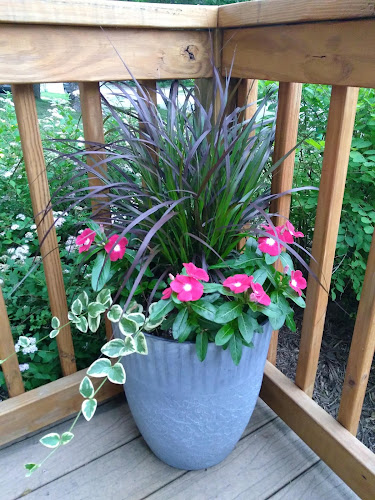We finished all the heavy work and except for keeping up with weeding and watering, now we can just go outside and enjoy the peace and quiet. As I sat in the yard and enjoyed the color and texture of the garden, and savored the satisfaction of having tidied up every single flower bed this year (unlike the previous several years), it occurred to me that gardening actually has a lot in common with quilting.
When I choose fabric for a quilt, I consider colors, values and scale. In my garden, green rules, but I make sure there are accent colors. I have perennials that bloom at different times, and some annuals that bloom all summer to make sure there is always a bloom to add an accent pop of color or contrast, like in a quilt. Even in the green, there is a wide variety: deep greens, gray greens, yellow greens... Let's not forget variegation for a little extra interest, like the print on a tone on tone fabric.
Pattern scale come into play as well. Small leaves, big leaves, medium leaves fill in for the size of the print on pretty fabrics. Texture is there as well: fuzzy leaves, smooth leaves, blade-like leaves and big heart shaped ones, serrated edges and smooth edges. They all play together to create movement and interest just like the different prints work together in a quilt.
I love playing with layout in my quilts and I do this in the garden as well. The eye prefers groupings and repetition, so I plan out groups of plants, and reuse varieties in different places to tie different parts of the garden together. Some of my flower beds are a bit like a sampler quilt, with one of this, and one of that. Some parts end up a little bit "improv" as I divide plants and just need somewhere to put the divisions but don't have a plan. Some parts are more formal, with similar plants in a line or an arc.
"Orphan blocks" get a chance to shine in the garden too. This redbud tree was an orphan. It was literally a stick with a root attached, no more than half and inch in diameter and 2 feet tall. My daughter brought it home from Girl Scout day camp many years ago. We plunked it onto a bucket of water beside the house because we couldn't figure out where to put it, then promptly forgot about it. A month later, we remembered it and decided to throw it out, only to discover it had grown leaves. How could we possibly get rid of it then? I researched red buds, picked a spot and now it is the centerpiece of this little bit of yard.
Look at those yellow daylilies. They are part of the plant stash. Yup, there's a stash in the garden too, in the form of perennials. Perennials grow bigger, then need to be divided, and voila! New plants for a new flowerbed. All those lilies are from divided plants, as are all the hostas below. And lamb's ear. That stuff just grows and grows anywhere! I wish fabric reproduced like that. Oh wait! The scraps in the scrap bin seem to do that.
Even the gardening tasks have quilting equivalents. Edging beds is like trimming units and blocks: it's tedious, but makes such a difference to the finished piece. Weeding is like trimming threads. Mulching. Well, it isn't quite analogous to basting, but I like doing that necessary task about as much as I enjoy basting a quilt, also a necessary chore. I don't know which part of quilting watering matches up with. I can only carry this analogy so far!
Finally, sitting quietly and admiring the tidy, blooming garden gives me the same kind of satisfaction as putting the last stitches into a quilt binding and curling up under the quilt for the first time. I'm sure as the summer heat and humidity kick in I'll migrate back to the sewing room during the day, but I'll keep enjoying the yard in the mornings and evenings.
I'll leave you with a few more garden photos to enjoy until I have more progress related to fabric to share.









